Response kits should be maintained at laboratories for potential use. These kits should be inspected by the LS/LSS routinely. (i.e, semi-annually and after use) to make sure they are available and ready to use. A specific person (or persons on a roster) should be allocated to inspect the kits on a periodic basis.
Chemical Spill Clean-Up Kits
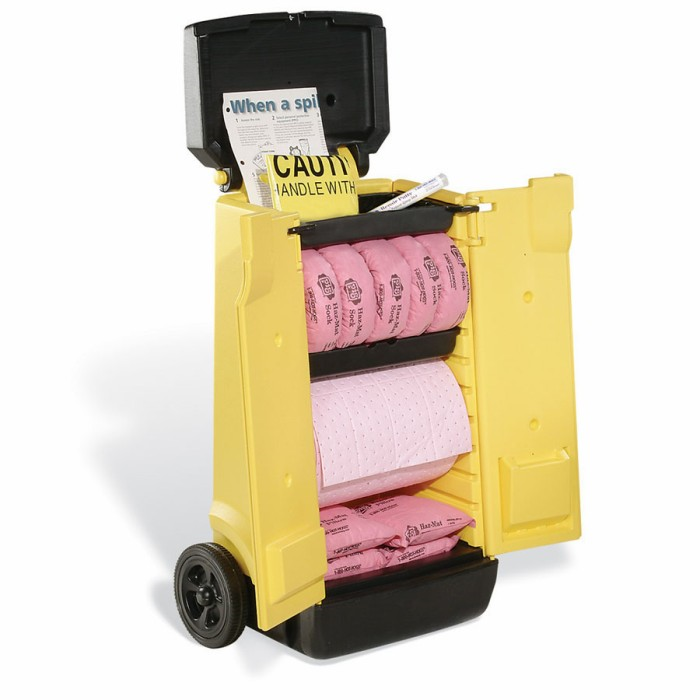
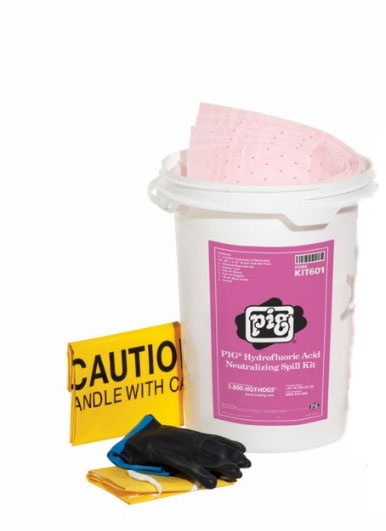
Chemical spill kit(Figure B.1) content may differ with the chemicals in laboratory needs. Kit contents are listed in Table B.1.
Figure B.1 PIG® HazMat Spill Kit and PIG® Hydrofluoric Acid Neutralizing Spill Kit in Bucket
| Table B.1 Spill Kit Content | |
|---|---|
| Spill Kit Content | Amount |
| ext. dia. 3" x 46" L PIG® HazMat Chemical Absorbent Sock (124CR) | 5 |
| 15" W x 60' L PIG® Rip-&-Fit® HazMat Mat Roll in Dispenser Box (MAT342) | 1 |
| 8" W x 8" L x 1" H PIG® HazMat Chemical Absorbent Pillow in Dispenser Box (PIL302) | 4 |
| 7" L PIG® Multi-Purpose Epoxy Putty (PTY201) | 1 |
| 18" W x 30" H "Caution - Handle with Care" Polyethylene Disposal Bags (BAG201-S) | 5 |
| Instructions | 1 |
Hydrofluoric Acid Spill Kit
Hydrofluoric acid (HF) has a number of physical, chemical, and toxicological properties that make it especially hazardous to handle. Both anhydrous hydrofluoric acid and aqueous solutions are clear, colorless, and highly corrosive liquids. When exposed to air, anhydrous HF and concentrated solutions produce pungent fumes, which are also dangerous. HF shares the corrosive properties common to mineral acids, but possesses the unique ability to cause deep tissue damage and systemic toxicity. Prevention of exposure or injury must be the primary goal when working with HF. However, any HF user must be intimately familiar with the appropriate first aid in case of an exposure.
HF Spill Kit (Figure B.1) must be supplied HF using laboratories. The spill kit content is given below Table B.2:
| Table B.2 Hydrofluoric Acid Neutralizing Spill Kit Content | |
|---|---|
| Spill Kit Content | Amount |
| PIG® Hydrofluoric Acid Neutralizer (GEN864) | 2 |
| 15" W x 20" L PIG® HazMat Mat Pad (MAT301) | 10 |
| 18" W x 30" H Polyethylene Disposal Bags (BAG201-S) | 5 |
| Economy Goggles (GLS290-AF) | 1 |
| Empty Bottle (CLN106) | 1 |
| Trigger Sprayer (CLN107) | 1 |
| Funnel | 1 |
| Zytron® 100 Level D Coveralls (WPL905-LXL) | 1 |
| 13" L Showa-Best Chem Master™ Neoprene Gloves (GLV213-XL) | 2 |
| Instructions | 1 |
First Aid Kits
First aid kit and supplies must be available to all users in case of emergency. First aid kits as size and content may vary upon number of people and particular laboratory situations.
For example, laboratories using hydrofluoric acid (HF) must supply calcium gluconate (C12H22CaO14) gel in case of skin contact. Each laboratory must also set up procedures to assure that supply stock in first aid kits are required level. Table B.3 shows First Aid Kit Contents, lists contents of the typical first aid kit.
| Table B.3 First Aid Kit Content | |||
|---|---|---|---|
| Required Items | Amount | ||
| Absorbent gauze | 0 pk (1) | 1 pk | 2 pk |
| Adhesive bandages | 1 bx (2) | 1 bx | 2 bx |
| Bandage compress | 1 pk | 2 pk | 2 pk |
| Eye dressing | 0 pk | 1 pk | 1 pk |
| Scissors and tweezers | 1 pk | 1 pk | 1 pk |
| Triangle bandages | 1 pk | 2 pk | 6 pk |
| Antiseptic soap/pads | 1 pk | 1 pk | 1 pk |
| Kling bandage | 1 dz (3) | 1 dz | 1 dz |
| Surgipad dressing | 2 ea (4) | 2 ea | 3 ea |
| Adhesive tape | 1 pk | 1 pk | 1 pk |
| Multi-trauma dressing | 0 ea | 1 ea | 1 ea |
| Kerlix dressing | 0 pk | 1 pk | 1 p |
(1): package(2): box(3):dozen(4):each
Burn Kits
Corrosive and irritant chemical products react with the biological components of the skin or eye. This gives rise to skin or eye lesions or burns, the consequences of which may be very serious.
In the event of contact between a corrosive or irritant chemical product and the skin or eye, it is essential to limit the reactions between these products and the tissues. The chemical product will react with the tissue for as long as it is in contact with the latter and no action halts its aggressiveness.
Diphoterine Wall-Mounted Station
Diphoterine (Figure B.2) solution is an emergency rinsing solution for splashes of chemical products. Its rapid use in case of contact between the skin or eye and a chemical product is intended to quickly eliminate the residual chemical product on the skin or in the eye. This makes it possible to limit the extent of the burns and lesions caused. Diphoterine facilitates secondary treatment of the burn injuries by restricting the extent and severity of the lesions.
How to use Diphoterine
- Apply Diphoterine solution within the first minute following the accident
- Uncap the 500 ml Diphoterine bottle and placed it on the affected eye. Use the full contents of a bottle on the affected eye.
- In case of skin splashes uncap the 200 ml of Diphoterine sprayer and use the full contents on the affected skin (face or arm).
- A 200 ml bottle of Afterwash II restores the physiological balance of the eye, and reduces the unpleasant sensations due to the chemical splash. Use the full contents on the affected eye
- After the accident seek expert medical attention.
Hexaflourine Wall-Mounted Station
Hexaflourine (Figure B.2) solution is a special emergency treatment product that actively washes and decontaminates HF acid splashes to the eye and skin. It was specifically developed in order to eliminate the dangers and risks associated with the use of hydrofluoric acid.
How to use Hexaflourine
- Apply Hexafluorine within the first minute following the accident
- Uncap the 500 ml Hexafluorine bottle. The entire contents of the bottle must be used on the affected eye.
- In case of skin splashes uncap the 50 ml of Calcium Gluconate gel and use the full contents on the affected skin (face or arm)
- After the accident seek expert medical attention.
Water Jel Kit
Water-Jel Burn Kit (Figure B.2) is a special water based gel that draws heat from the burn. It reduces pain, cools the skin and prevents airborne infection. It prevents the deepening of the burn when it is applied quickly enough. It is used for all types of burns (heat, steam, electricity, combustion, explosion, radiation).
How to use Waterjel
- In case of accident open the thermal burn kit
- Select a dressing in accordance with size of burn.
- Tear foil package open and remove the dressing.
- Unfold and apply dressing immediately to burn area and pour the excess gel remaining in the package over the dressing and any debris or clothing adhering to the burn.
- Leave the dressing in place. Seek expert medical attention.
INSTRUCTIONS FOR USE: BURNJEL
- Used for minor burns
- Apply the gel to burn area.
- Leave the gel on the burn area app. 45 minutes.
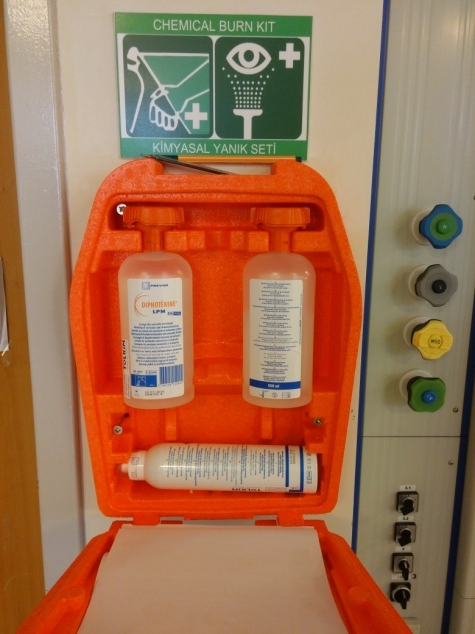
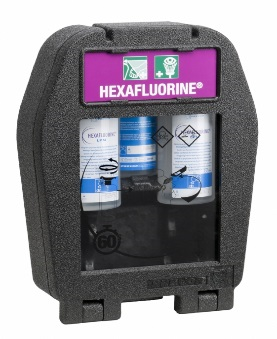
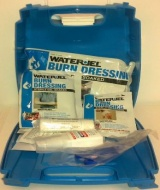
Figure B.2 Chemical and Thermal Burn Kits